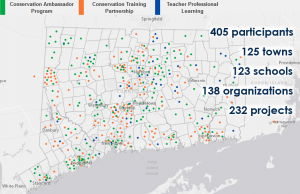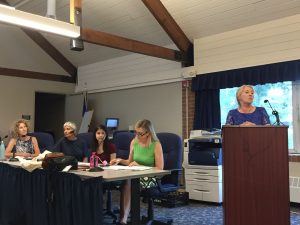Every year, UConn’s Natural Resources Conservation Academy supports ~50 teen-adult partnerships as the teams embark on a common goal: to tackle an environmental issue that is relevant to their community. These intergenerational conservation efforts span an incredible range of topics (e.g., mapping, invasive species, restoration, soils & agriculture, wildlife & fisheries, public outreach, and water quality), and involve students and adults representing the breadth and diversity of Connecticut (see map below).
Explore the NRCA interactive map by clicking on a dot to learn more about the participant, their community partner or teammate, their affiliation and their conservation project. Participants from each of the three NRCA programs are indicated by the color of the dot. To date, 405 teen and adult participants from throughout CT have undertaken 232 community projects!
These citizen efforts result in real benefits for the local community. One example of NRCA project impacts is through their contribution to participants town’s Sustainable CT efforts (learn more at sustainablect.org)! Read about two examples below:
- Nisha (rising senior at Darien High School) is working with the Darien Advisory Committee to help the Town of Darien become a certified Sustainable CT town. Her project focused on water conservation. She developed a survey that allowed town residents to report their water usage as well as learn how they can reduce their water consumption. The survey was distributed widely to town residents through social media and two press articles written by Nisha (see Darienite and Darien Times articles). Working with the Darien Pollinator Pathway, the Darien Nature Center and Aquarion, Nisha co-hosted a water conservation workshop as well.
Nisha (third person from right or left)—a 2019 NRCA CTP participant—co-hosting water conservation workshop with representatives from the Darien Pollinator Pathway, the Darien Nature Center and Aquarion.
- Ming (rising freshman at East Lyme High School) and Tom (Master Natural Program) are helping the Town of East Lyme map and monitor invasive plants as well as educate the public about the scope of this issue in the town. They are using smartphone mapping technology (Track-Kit and Epicollect) to map and develop a monitoring survey that can be used by the public to report sightings of 5 invasive plant species in Oswegatchie Hills. To accompany the survey, they are developing a brochure with descriptions and pictures the invasive species. The mapping and monitoring results will inform how the park is managed and contribute to the town’s Sustainable CT certification.
Ming (left) and Tom (right)—a 2019 NRCA CTP team—mapping invasive plants in Oswegatchie Hills.
Interested in helping with conservation efforts in your hometown with the support of one of UConn’s Natural Resources Conservation Academy Programs? Email us (nrca@uconn.edu) or learn more at nrca.uconn.edu.


